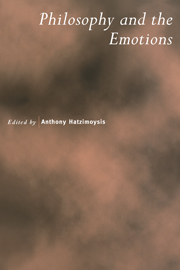Book contents
- Frontmatter
- Contents
- Preface
- Notes on Contributors
- I Emotions, Thoughts and Feelings: What is a ‘Cognitive Theory’ of the Emotions and Does it Neglect Affectivity?
- II The Emotions and their Philosophy of Mind
- III Basic Emotions, Complex Emotions, Machiavellian Emotions
- IV Emotion, Psychosemantics, and Embodied Appraisals
- V Emotions and the Problem of Other Minds
- VI Emotional Feelings and Intentionalism
- VII Emotions, Rationality, and Mind/Body
- VIII The significance of recalcitrant emotion (or, anti-quasijudgmentalism)
- IX The Logic of Emotions
- X Emotion and Desire in Self-Deception
- XI Emotion, Weakness of Will, and the Normative Conception of Agency
- XII Narrative and Perspective; Values and Appropriate Emotions
- XIII Passion and Politics
- XIV Don't Worry, Feel Guilty
- Index
X - Emotion and Desire in Self-Deception
Published online by Cambridge University Press: 06 January 2010
- Frontmatter
- Contents
- Preface
- Notes on Contributors
- I Emotions, Thoughts and Feelings: What is a ‘Cognitive Theory’ of the Emotions and Does it Neglect Affectivity?
- II The Emotions and their Philosophy of Mind
- III Basic Emotions, Complex Emotions, Machiavellian Emotions
- IV Emotion, Psychosemantics, and Embodied Appraisals
- V Emotions and the Problem of Other Minds
- VI Emotional Feelings and Intentionalism
- VII Emotions, Rationality, and Mind/Body
- VIII The significance of recalcitrant emotion (or, anti-quasijudgmentalism)
- IX The Logic of Emotions
- X Emotion and Desire in Self-Deception
- XI Emotion, Weakness of Will, and the Normative Conception of Agency
- XII Narrative and Perspective; Values and Appropriate Emotions
- XIII Passion and Politics
- XIV Don't Worry, Feel Guilty
- Index
Summary
According to a traditional view of self-deception, the phenomenon is an intrapersonal analogue of stereotypical interpersonal deception. In the latter case, deceivers intentionally deceive others into believing something, p, and there is a time at which the deceivers believe that p is false while their victims falsely believe that p is true. If self-deception is properly understood on this model, selfdeceivers intentionally deceive themselves into believing something, p, and there is a time at which they believe that p is false while also believing that p is true.
Elsewhere (most recently in Mele, 2001), I have criticized the traditional conception of self-deception and defended an alternative, deflationary view according to which self-deception does not entail any of the following: intentionally deceiving oneself; intending (or trying) to deceive oneself, or to make it easier for oneself to believe something; concurrently believing each of two contradictory propositions. Indeed, I have argued that garden-variety instances of selfdeception do not include any of these things. On my view, to put it simply, people enter self-deception in acquiring a belief that p if and only if p is false and they acquire the belief in a suitably biased way. Obviously, this shoulders me with the burden of showing what suitable bias amounts to, and I have had a lot to say about that. The suitability at issue is a matter of kind of bias, degree of bias, and the nondeviance of causal connections between biasing processes (or events) and the acquisition of the belief that p.
In Mele, 2001 (pp. 106–12), I suggested a test for relevant bias. I called it ‘the impartial observer test,’ and I argued that its appropriateness is underwritten by…
- Type
- Chapter
- Information
- Philosophy and the Emotions , pp. 163 - 180Publisher: Cambridge University PressPrint publication year: 2003
- 2
- Cited by



